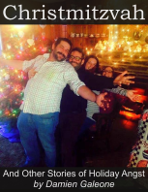 We are trying to decipher the meat.
We are trying to decipher the meat.
Everything else on the plate is of obvious origin: Eggs, bread, tomatoes. But the meat is like none we have seen before; it’s flat and holds the feel and consistency of a protractor. We are in Israel, thus eliminating the possibility of porcine origin.
It’s 7 a.m. and the café we’re sitting in rests in between Jerusalem’s Muslim and Jewish Quarters. We are enjoying the early morning hour, which is the clichéd calm before the clichéd storm. It’s still cool; the July heat will attack the city in a short while, covering the palms and the Arab rugs, the gunky awnings and thousands of people with an afghan of unbearable heat. We’ll escape the heat in the afternoon by burrowing into the covered markets in the Muslim Quarter and dealing with the stench and dankness in order to not melt. So now we sit in the relative cool and the last quiet moments the day will enjoy until evening.
And we decipher our meat.
We raise the flat twigs of bacon into the air as though they are shot glasses and tap them together over the plates and the coffee. “To frog bacon!” Mark says. “Lechaim!” I say. Then we bite it, snapping it like petrified loose leaf. The waitress does not care.
We landed in Tel Aviv on the heaviest day of bombing in Israeli history, and Hezbollah and the IDF are still going at it in the north. We had already bought our tickets, so we figured what the hell. We just won’t go north. Mark is the best travel partner I have ever had; we both love off-the-beaten-path adventure, getting excited over nerdy artifacts and holidays which could be a rejected Indiana Jones script. We will both try anything, like traveling in wartime Israel and eating frog bacon.
We soon learn that to describe a day in Israel is as inexplicable as describing a day on the surface of Neptune.
There are so many clashing personalities and cultures, religions and ethnogeneses. The muezzin calls Muslims to prayer five times a day, the stinky Via Dolorosa, where Christ was marched to his death carrying logs. Golgotha, where he was crucified, and which is now inside a church where Marco Polo was let in by the great great great great great great great great great grandfather of the man who lets us in. An obese tourist with a massive camera standing in front of the Wailing Wall, asking in a loud screech, “Where’s the wall?” And the heavily armed guard who points out the most holy structure in the history of Judaism with a machine gun. “Oh,” she waddles off.
It is an incongruous city. In the center there is the constant threat of violence, exacerbated by military violence in the north. There is a constant volley of shouting – in the markets, on the streets, between friends and enemies. There are thousands of people at the walls, gates and temples, people selling fruit and rolling carts and wagons; a tension that exists over everything. And then there are the sloping, relatively peaceful streets of the Armenian Quarter and the sleepy, shady Coptic Quarter.
We are in an inconceivable and indecipherable land, which is like walking around a virtual history book, only real. Our quiet early morning breakfasts serve as a solace from this intensity; the only recognizable, comfortable and safe respite we have before another day of seeing things only heard about in Latin class or in some vague religious reference. Today it’s Masada, the Dead Sea, and then Jericho, the oldest city on Earth.
And perhaps the frog bacon is that little bit of mystery to our breakfast, there to remind us that we are in a different place that is not meant to be fully understood.
So for the moment, before the day begins, we stick to things understandable. And for everything else, we try to decipher the meat.

#1 by Andy on March 25, 2013 - 7:28 pm
I’m still jealous of this trip. I still laugh at how bad you guys smelled when you returned; that heat must have been epic.